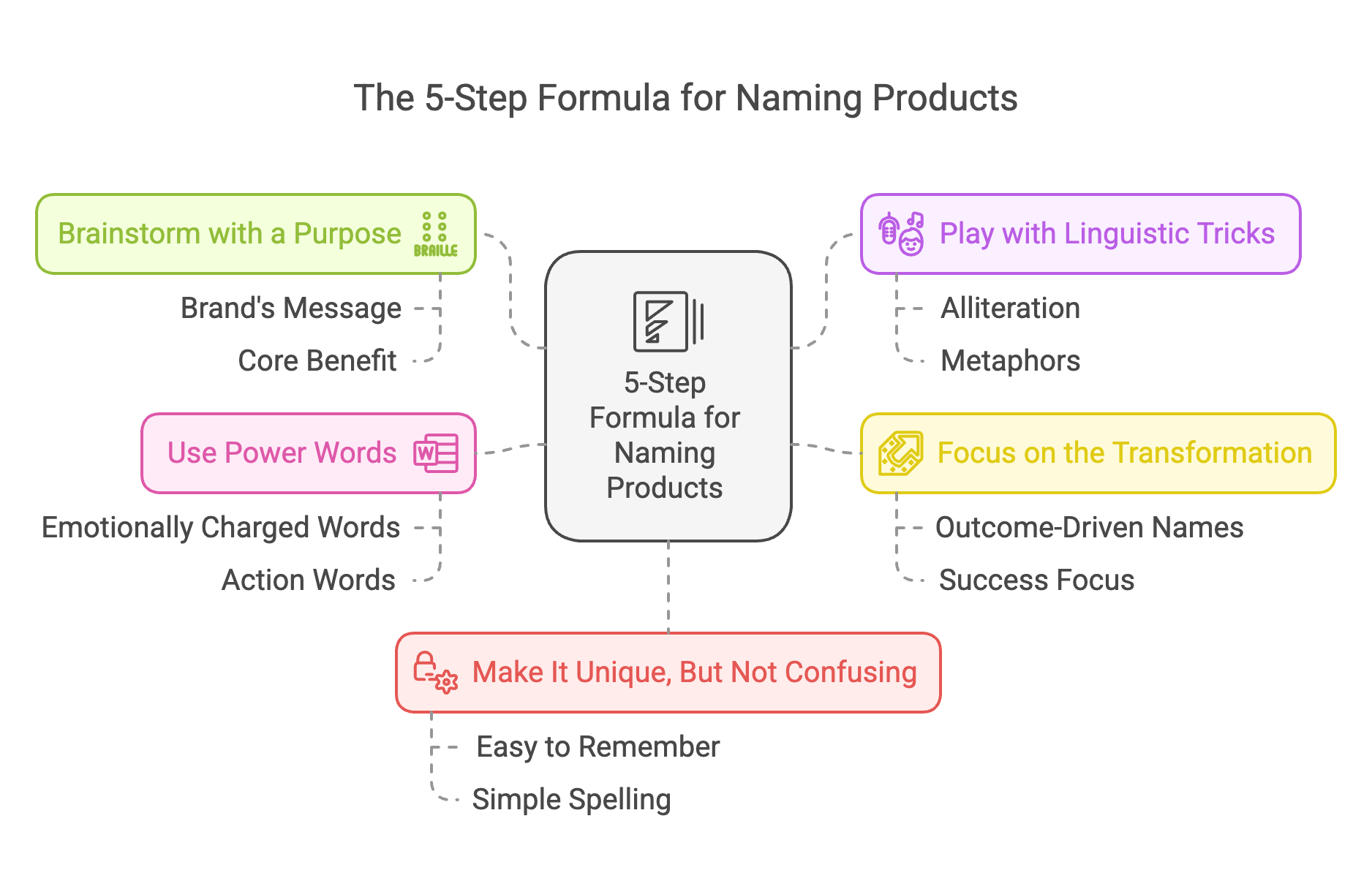
Coming up with a great product name isn’t just about sounding cool—it’s about grabbing attention, creating curiosity, and making your brand unforgettable. Think about some of the most iconic product names: iPhone, Tesla Model S, Kindle. They aren’t just words; they create an instant connection with their audience and that’s all thanks to the perfect product naming strategy!
If you’re launching a course, book, program, or physical product, your naming strategy can make or break its success. A generic name will get lost in the noise, while a strategic one can increase perceived value, improve brand recall, and even boost conversions.
In this product naming strategy, we’ll break down how to craft a product name that sticks, using real-world examples—including how Starbucks nailed it with their drink sizes—and practical strategies you can use today.
Why Your Product Name Matters
Before diving into the naming process, it’s crucial to understand why choosing the right product name is a foundational part of a successful product naming strategy. Your product’s name isn’t just a label—it’s a powerful marketing tool that can determine whether your audience engages with your brand or moves on to a competitor. The right name creates an instant impression, communicates value, and builds trust before a customer even learns what your product does.
A well-thought-out product naming strategy also ensures brand consistency and market positioning. Whether you’re launching a course, book, software, or physical product, a name that aligns with your brand voice and target audience can make a world of difference. Strong product names help clarify who your product is for, what problem it solves, and why it’s worth their attention. On the flip side, a weak or generic name can lead to market confusion, lack of interest, and missed sales opportunities.
Key Reasons Why Your Product Name Matters
- First Impressions Matter – Your product name is often the first interaction potential customers have with your brand. A strong name piques curiosity and invites engagement.
- It Sets You Apart – In a crowded market, a creative and unique name helps you differentiate your product from competitors.
- Memorability Leads to Sales – If customers can’t remember your product name, they can’t search for it, recommend it, or buy it again.
- Emotional Connection Drives Loyalty – Names evoke feelings, and a name that resonates with your audience can foster brand loyalty.
Beyond just grabbing attention, an effective product name enhances marketing efforts, making it easier for your audience to recall, share, and talk about your brand. The right name not only helps boost visibility and searchability, but it also reinforces your product’s core message—making marketing campaigns more cohesive and impactful.
A weak name, on the other hand, can be forgettable, confusing, or even misleading—making it harder to gain traction. Investing time in a strong product naming strategy ensures that your product stands out, attracts attention, and is positioned for long-term success.

The Starbucks Example: The Power of Naming
One of the best real-world examples of strategic naming comes from Starbucks and their unique coffee size names. Instead of the standard small, medium, and large, Starbucks introduced Tall, Grande, and Venti—a move that initially confused people but ultimately became an iconic branding decision.
Howard Schultz, the former CEO of Starbucks, credits Terry Heckler, the brand’s designer, for rethinking language in a way that made Starbucks feel more premium. By moving away from generic size names and using Italian-inspired terms, they created an elevated experience that customers embraced.
Why it worked:
- “Grande” sounds more luxurious than “medium.”
- “Venti” (which means 20 in Italian) makes it feel fancy and European.
- It differentiated Starbucks from every other coffee shop.
The lesson here? Great names don’t just describe a product—they create a brand identity. Starbucks’ naming strategy helped position them as more than just another coffee shop. It made ordering coffee feel different, exclusive, and even aspirational.
Key Elements of a Strong Product Naming Strategy
If you want to create a powerful product name, keep these core principles in mind. A well-crafted product naming strategy ensures that your brand stands out, resonates with your audience, and remains relevant as your business evolves. The best product names don’t just sound good—they convey meaning, create an emotional impact, and support long-term brand growth. Here’s how to ensure your product name meets these essential criteria:
1. Clarity and Relevance
Your name should give people a clear idea of what your product does or what they can expect. Avoid overly complicated, abstract, or vague names that require too much explanation. A strong product name instantly communicates purpose and value, making it easier for potential customers to understand and remember your brand.
✅ Example: The project management tool Trello is a play on the word “trellis,” which signifies structure and organization—exactly what the software helps users achieve. Its simple yet relevant name makes it easy to recognize and associate with productivity.
2. Emotional Connection
Names that evoke emotions or tell a story tend to stick better. A compelling product naming strategy leverages meaningful connections to make your product more memorable. People are drawn to names that inspire, intrigue, or spark curiosity.
✅ Example: Nike is named after the Greek goddess of victory, reinforcing its brand message of strength, perseverance, and achievement. The name creates an instant emotional connection with athletes and those who aspire to greatness.
3. Uniqueness and Differentiation
A great name sets you apart from competitors. In a crowded market, a generic or overused name won’t help you stand out. Before settling on a name, research what’s already out there to ensure you’re not blending into the noise. A distinct name builds brand recognition and helps your product become instantly identifiable.
✅ Example: The search engine “Google” is a playful take on the word “googol,” a mathematical term for a number with 100 zeros. It’s unique, memorable, and perfectly represents the company’s mission to organize massive amounts of information.
4. Scalability for Growth
Will the name still make sense if your brand expands? A name that’s too narrow or limiting can restrict your growth potential. When choosing a product name, think long-term—does it allow you to pivot, expand, or evolve without losing its core identity?
✅ Example: Amazon started as an online bookstore, but its name—inspired by the vast Amazon rainforest—allowed it to grow into a global marketplace offering everything from electronics to groceries. A more specific name, like “Online Book Hub,” would have limited the brand’s ability to scale.
By focusing on clarity, emotional impact, uniqueness, and future scalability, you can develop a product naming strategy that strengthens your brand, captivates your audience, and stands the test of time.

The 5-Step Formula for Naming Your Product or Program
So how do you name your product, course, or book in a way that sticks? Here’s the process:
1. Brainstorm with a Purpose
Before you start throwing random names on a whiteboard, get clear on your brand’s message. Your product name should reflect its core benefit, audience, and the transformation it provides.
Start by asking:
- What problem does my product solve?
- What emotions do I want my audience to feel?
- How do I want my brand to be perceived—innovative, luxurious, approachable?
A great way to generate ideas is by mind mapping, using word associations, or even AI-powered name generators to spark inspiration. The goal isn’t to land on the perfect name immediately but to create a pool of potential options to refine later.
2. Play with Linguistic Tricks
Some of the most memorable brand names use clever linguistic elements that make them easy to recall. Here are a few techniques to consider:
- Alliteration → Repeating sounds make names catchy and fluid.
Examples: Coca-Cola, PayPal, Best Buy - Rhyming → Rhyming words have a natural flow that makes them fun to say.
Examples: StubHub, YouTube, Mello Yello - Metaphors & Symbolism → Using symbolic words can add deeper meaning.
Examples: Jaguar (cars → speed & power), Apple (tech → knowledge & simplicity), Amazon (retail giant → vast selection)
Try combining these techniques to create a name that’s fun to say, easy to remember, and deeply meaningful.
3. Focus on the Transformation
People don’t buy products—they buy the outcome that product gives them. Your name should reflect what’s in it for them and highlight the end result.
- Instead of “6-Week Weight Loss Plan”, try “Lean in 42” (specific & outcome-driven)
- Instead of “Business Growth Course”, go with “Revenue Accelerator” (speed & impact)
Think about what success looks like for your audience, then craft a name that speaks directly to that transformation.
4. Use Power Words That Trigger Emotion
Words carry psychological weight, and using the right ones can make your product name more powerful. Certain words evoke curiosity, urgency, and authority, driving action.
Here are some powerful words that work well in product names:
- “Secrets” → Makes people feel like they’re getting insider knowledge
- “Blueprint” → Sounds structured and easy to follow
- “Unleashed” → Feels powerful and full of potential
By incorporating action-driven, emotionally charged words, your product name becomes more compelling and naturally attracts attention.
5. Make It Unique, But Not Confusing
A great product name is distinctive yet easy to understand. If people can’t pronounce, spell, or remember it, they won’t talk about it—and word-of-mouth marketing is one of the most powerful growth drivers.
- Bad example: “LeadXpertify” – Confusing, awkward spelling, hard to say
- Good example: “ClickFunnels” – Instantly tells you what it does
Keep your name simple, catchy, and intuitive so people can remember and share it effortlessly.
6. Test Before You Commit
Before you finalize your product name, put it to the test. What sounds great to you might not resonate with your audience. Here’s how to validate it:
- Say it out loud – Does it sound good when spoken?
- Ask your audience – Do they instantly understand what it means?
- Check for availability – Can you secure the domain name and social media handles?
Testing ensures that your name works in real-world scenarios and makes an impact before you invest in branding, marketing, and product development.
Other Examples of Winning Product Naming Strategies
A strong product name isn’t just about sounding good—it’s about conveying a clear message, sparking curiosity, and making an emotional connection with your audience. Some of the most successful product names have achieved this by being simple yet powerful, evoking imagery or emotions that instantly make them memorable. When done right, a name alone can generate interest, increase perceived value, and help build a loyal customer base.
One of the best ways to craft a winning product name is to study brands that have already nailed it. Whether it’s a tech tool, an online course, a coaching program, or a bestselling book, certain names stand out because they hit the right balance between clarity, creativity, and relevance. Below are examples of names that have done just that.
Need inspiration? Here are real-world examples of great naming in different industries:
- Tech – “Slack” (simple, unexpected, and memorable).
- Courses – “The Knowledge Business Blueprint” (authority and step-by-step).
- Coaching Programs – “6-Figure Freelancer” (specific and aspirational).
- Books – “Atomic Habits” (small changes = big impact).
- Physical Products – “Squatty Potty” (funny, memorable, clear).
Each of these taps into psychology, branding, and marketing—which is exactly what you want for your product. Whether you’re naming a new program, a bestselling book, or a software tool, learning from these successful examples can help guide you toward a name that resonates with your target audience and sets your brand apart.

Common Pitfalls to Avoid When Naming a Product
Even the best ideas can flop if you don’t avoid these common mistakes:
1. Overcomplicated or Hard-to-Pronounce Names
If customers can’t say it, they won’t share it. Avoid overly complex words or unusual spellings that create confusion.
2. Names That Don’t Align with Your Brand Message
Your name should reflect what your product does or stands for. A misaligned name can create false expectations.
3. Legal and Trademark Issues
Always check for trademarks and domain availability before finalizing your name. The last thing you want is to build a brand around a name you can’t legally use.
Why Your Name Is Your First Marketing Move
A strong product naming strategy is about more than just coming up with something catchy—it’s about creating a name that resonates, sticks, and positions your brand for success.
Take the time to brainstorm, refine, and test your product name before launch. Whether you’re naming a digital product, course, book, or business, the right name can make all the difference in how your audience perceives and remembers it.
And remember—sometimes, the boldest naming decisions (like Starbucks ditching “small, medium, and large”) are the ones that stand the test of time.

FAQ’s For Your Product Naming Strategy
1. Why is a product name so important?
Your product name is often the first impression customers get. A strong name enhances brand recognition, makes your product memorable, and helps differentiate it from competitors.
2. How do I choose the right name for my product?
Start by identifying your product’s core benefits, target audience, and brand identity. Brainstorm creative names, test them for clarity and memorability, and check for trademarks before finalizing.
3. What are some common mistakes to avoid when naming a product?
Avoid names that are too complicated, hard to pronounce, or misaligned with your brand message. Also, always check for trademark conflicts to prevent legal issues down the road.
4. Should my product name be descriptive or abstract?
Both approaches can work! Descriptive names (e.g., PayPal) make it clear what the product does, while abstract names (e.g., Google) allow for more branding flexibility. It depends on your long-term vision.
5. How do I test if my product name is effective?
Run a survey or ask potential customers for feedback. A great name should be easy to pronounce, recall, and spell. If people struggle with it, consider refining it.
6. Can I change my product name later?
Yes, but rebranding can be costly and confusing for your audience. If you need to change your name, do it early and have a strong marketing plan to communicate the transition.
7. What if my preferred product name is already taken?
If your ideal name is trademarked or unavailable, try slight modifications, adding a unique word, or using a different spelling—just ensure it remains easy to remember and aligns with your brand.
8. How did Starbucks’ naming strategy help its brand?
By moving away from generic size names (small, medium, large) to Tall, Grande, and Venti, Starbucks created a premium and unique ordering experience that became part of their brand identity.
9. Should my product name include keywords for SEO?
If applicable, incorporating keywords can help with discoverability, especially for online products or courses. However, don’t force it—clarity and brand consistency matter more.
10. How long should I spend on product naming?
Don’t rush the process, but don’t get stuck either. A well-thought-out name can be a game-changer, so take the time to brainstorm, refine, and test before launching.
